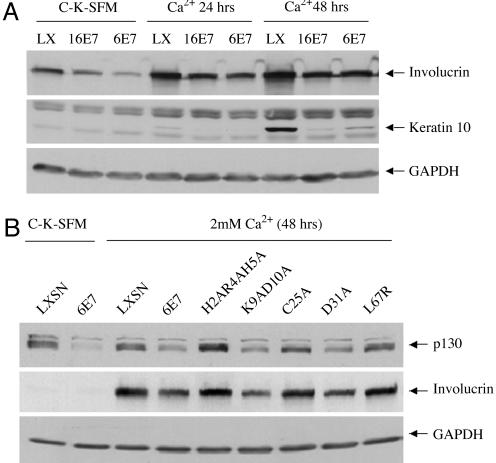Fig. 5.
HPV E7-mediated decreased/delayed keratinocyte differentiation and correlation with the ability of HPV-6 E7 to destabilize p130. (A) Effect of HPV-16 E7 and HPV-6 E7 on differentiation. HFKs were transduced and grown as described in Fig. 1. Whole-cell lysates were analyzed on Western blots by using antibodies to involucrin, keratin 10, and GAPDH. The average ± SD of involucrin in three independent experiments, corrected for GAPDH, are as follows: relative to LXSN in C-K-SFM, 0.54 ± 0.17 (16E7) and 0.35 ± 0.18 (6E7); relative to LXSN in CaCl2 for 24 h, 0.46 ± 0.11 (16E7) and 0.45 ± 0.12 (6E7); relative to LXSN in CaCl2 for 48 h, 0.63 ± 0.15 (16E7) and 0.54 ± 0.19 (6E7). The average ± SD of keratin 10 in three independent experiments, corrected for GAPDH and relative to LXSN in CaCl2 for 48 h, was 0.04 ± 0.00 (16E7) and 0.15 ± 0.05 (6E7). (B) Effect of HPV-6 E7 and HPV-6 E7 mutants on differentiation. HFKs were infected and grown as in Fig. 1, and immunoblots were performed on whole-cell extracts by using antibodies to p130, involucrin, and GAPDH. The average ± SD of p130 in three independent experiments, corrected for GAPDH, was as follows: relative to LXSN in C-K-SFM, 0.31 ± 0.08 (6E7); relative to LXSN in CaCl2, 0.43 ± 0.02 (6E7), 1.08 ± 0.10 (H2AR4AH5A), 0.52 ± 0.13 (K9AD10A), 0.86 ± 0.09 (C25A), 0.48 ± 0.08 (D31A), and 0.88 ± 0.10 (L67R); the average ± SD of involucrin relative to LXSN in CaCl2 was 0.38 ± 0.19 (6E7), 0.89 ± 0.03 (H2AR4AH5A), 0.51 ± 0.14 (K9AD10A), 0.88 ± 0.14 (C25A), 0.43 ± 0.09 (D31A), and 0.79 ± 0.01 (L67R).

